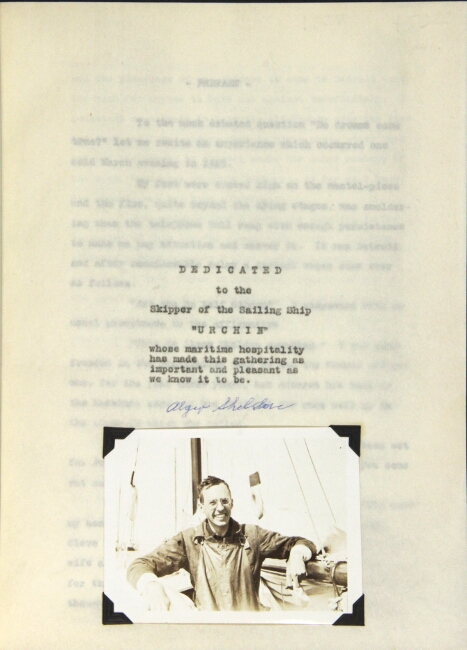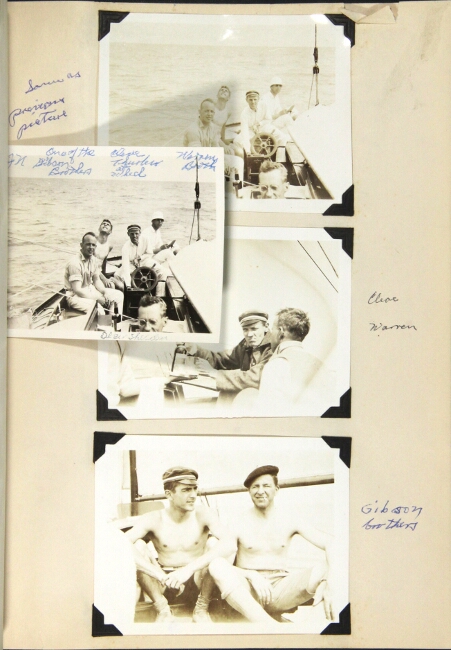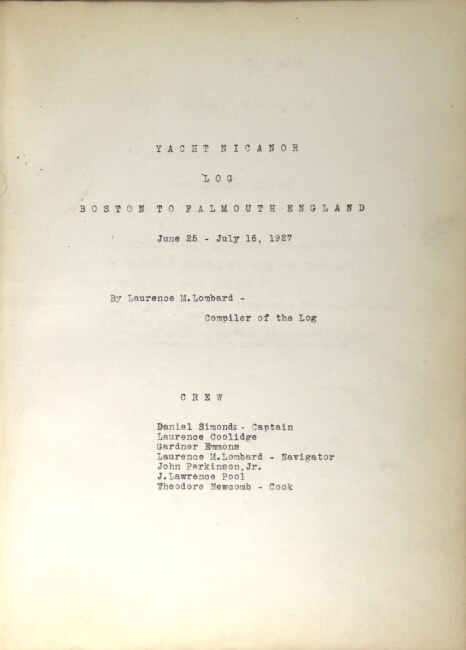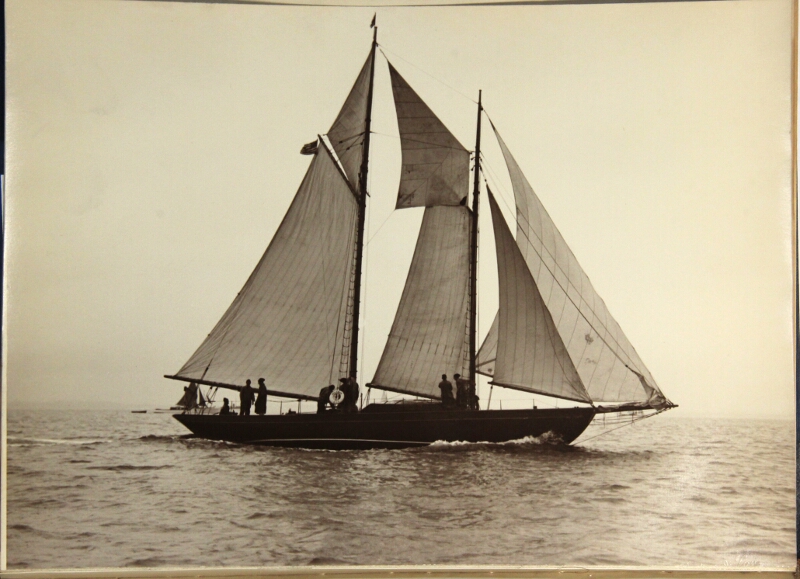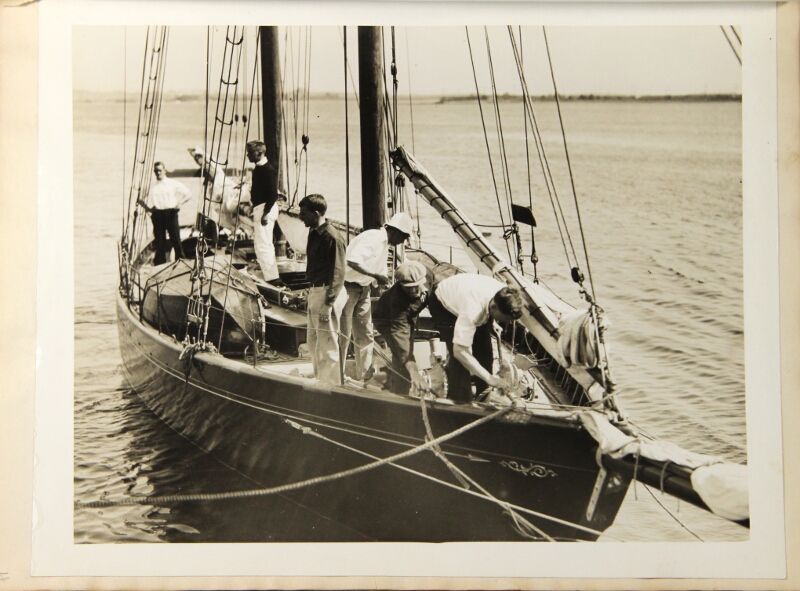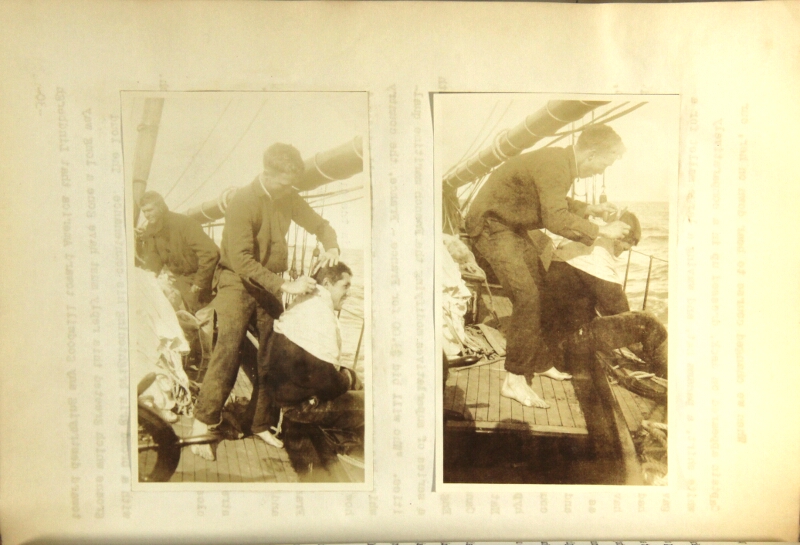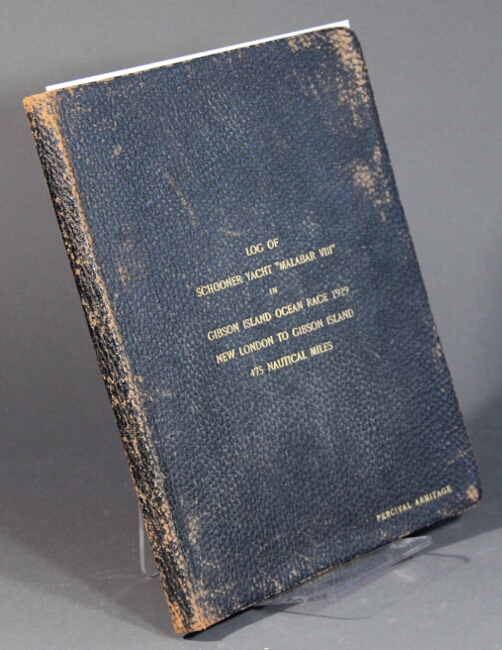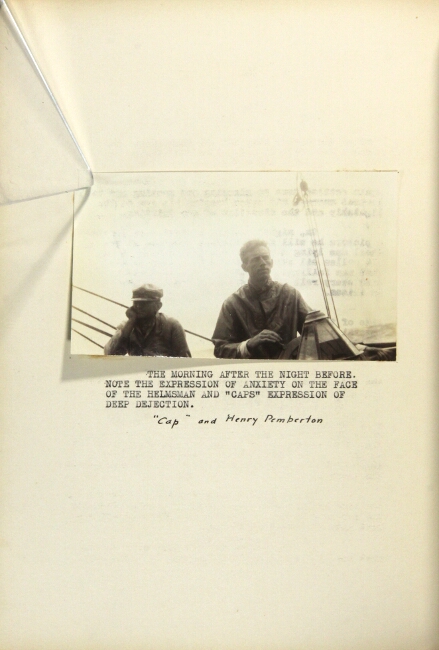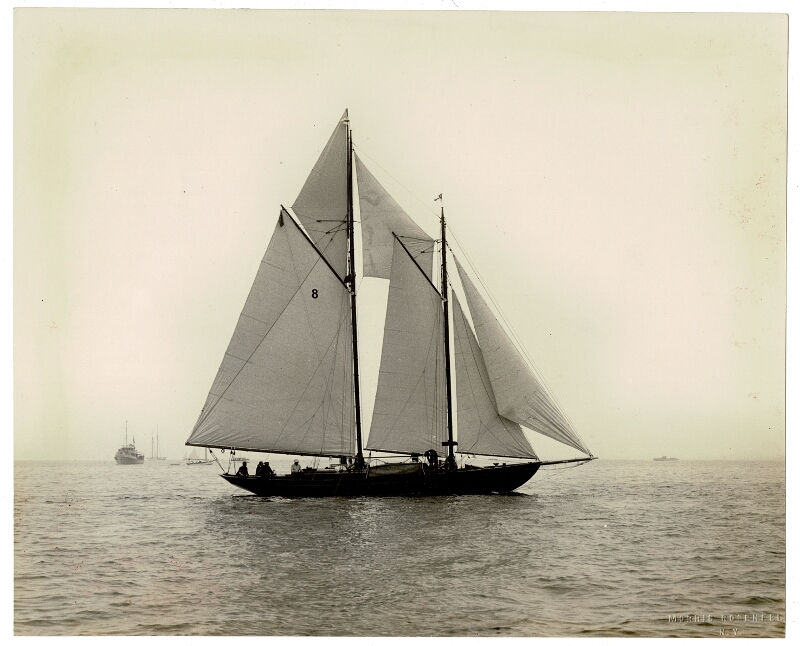American Manuscripts
Naval & Nautical
To order call toll-free at (800) 441-0076 or 651-290-0700
or email rulon@rulon.com
or, click on the "add to cart" link to order through our website. Phone calls and emails are generally quicker.
All books are guaranteed genuine as described, and are returnable for any reason during the first week after receipt. If you are returning an item, please let us know so we can make it available to another customer.
Shipping and handling charges are extra and billed at cost.



1. Day book. Newport: 1861-64.
$1,400
Tall, narrow folio (approx. 16" x 8"), 576 numbered pages accomplished in ink; original full reversed calf, black leather labels on spine; binding slightly skewed; overall very good; internally clean, neat, and legible.
George Bowen (1799-1879) was a Quaker merchant of Newport, who did brisk business in Newport from Bowen's Wharf, a wharf that exists to this day. His parents were Jonathan and Sarah (Shove) Bowen. His wife, whom he married later in life in 1854, was Cynthia Ingersoll Jones, who was born in China. The Newport City Directory of 1865 lists George Bowen as a ship's chandler on Bowen's Wharf. In 1871, he was also a director of the New England Commercial Bank in Newport and lived at 17 Pelham Street.
According to the Hagley Museum and Library in Wilmington, Delaware, which holds some of the George Bowen & Co. records between 1829-1898: "George Bowen founded a ship chandler's business in Newport, R.I., around 1829. By the 1850s the business had expanded to include the retailing of anthracite coal from Pennsylvania and fuel wood, which was sold primarily for domestic heating. The firm also did a general commission business under the rubric of George Bowen & Company. The ship chandler's business was gradually phased out beginning in the late 1870s, and the firm became exclusively a dealer in coal, wood, and kindlings. By the 1890s it was being carried out by agents for the heirs of George Bowen."
This very extensive day book lists thousands of transactions between Bowen and his customers, which included not only the local residents, but other concerns as well. With so many familiar names here it's hard to be comprehensive: James L. Hazard, William Littlefield, Isaiah Pitman, Thomas Goddard, George Mason, Benjamin Almy, George Coggeshall, Bowen Briggs, John D. Herreshoff, Clark Burdick, Mary Rodman, John Cottrell, Frederick Lawton, William Brownell, and many, many others. Notable are the many transactions with John LaFarge (1835-1910), the stained-glass artist who was working and studying in Newport at the time.
Other customers included a veritable fleet of ships: the sloops Pearl, Resolution, Congress, M. E. Wells, William P. Magnum; the schooners Golden Rod, Abby H. Brown, Zoe, Evergreen, Mexico, and the River Queen; the brigs Redwood and John Pierce; the bark Martha Anna; the steamboats Perry and Fanny, and many others. Other transactions were with local businesses and government entities such as the American Insurance Company, the City of Newport, the Third Rhode Island Cavalry, Wilson Manufacturing, Fall River Iron Works, the Quartermaster at Fort Adams, Lime Rock Light, and "U.S. for light boat at Brenton Reef."
Coal seems to be the big seller, but Bowen was also dealing in cord wood, sails, paints and varnishes, manila rope, putty, screws, linseed oil, oars, compasses, and even potatoes. The entries generally include the customers' names, the products purchased, and the cost of the goods.

2. Midshipman's manuscript "Journal of a cruise in the U.S. Ship of the Line Columbus, bearing the broad pendant [sic] of Commodore Char[le]s W. Morgan," and a subsequent cruise on board the U.S. Sloop of War, Jamestown. At sea: 1842-45.
$3,500
Folio; 199, 101-200, [134] pages (approximately 433 pages in all); pen-and-ink title with an original drawing of a sailing vessel of war on the title page; a second drawing of Columbus occurs inside; contemporary full calf; gilt-decorated spine, decorative gilt borders on covers; written in a neat, legible hand; very good and sound.
With the author’s name (Midshipman) "G. D. Chenoweth, U. S. Navy," stamped in gilt on the upper cover. U.S.S. Columbus was a 90-gun ship of the line in the United States Navy. She was launched on 1 March 1819 at the Washington Navy Yard and commissioned on 7 September 1819.
Chenoweth, a Kentucky native, received his midshipman’s warrant on 19 October 1841. He died in April 1847, but where and from what is not clear. His journal is a lengthy and detailed record spanning the three years from August 1842 to August 1845.
This is a fine example of a U.S. Navy midshipman's journal, proper, neat, and orderly. Chenoweth generally records one day's particulars per page, noting almost always location (at sea; Bay of Gibraltar, off Georgetown, Harbor of Rio de Janeiro, Navy Yard, Gosport, Va., Naval Anchorage, Norfolk, Porto Praya, Port Mahon, etc.); course sailed, nautical speed, and wind direction for each of the 24 hours in the day. These are followed by "Remarks" which, while at sea, are generally rather perfunctory and taking no more than 8-12 lines; but others are quite lengthy, especially when in a port-of-call, often running to multiple pages. At Port Mahon, for example, the remarks run to two-and-a-half pages at the first calling, and six pages at the second calling; at Toulon, two pages; at Genoa 22 pages (over a four-month layover); at Rio de Janeiro, 18 pages (over a two-and-a-half-month layover).
Chenoweth commences his journal at Boston, August 3rd 1842, noting that at 3:30 p.m. on that day the 74-gun Ship of the Line Columbus was commissioned. [This is at variance with the Wikipedia entry on the ship.] He then lists the 60-odd officers, midshipmen, and mates who have reported for duty; Captain William A. Spencer is the commissioning commanding officer.
The next three weeks are filled with entries reflecting preparations for the ship to deploy to the Mediterranean. Included are accounts of taking on provisions, and equipment (including "three boxes of books for the apprentice boys"), and the release of a minor back to his parents who had signed on illegally.
"At one o'clock p.m. called hands to bend sails and bent the courses, topsails, jib, and spanker. Received stores in some of the departments. At 5 p.m. furl'd sails. Hoisted a red flag at the fore and received on board one hundred and twenty five barrels of powder. Transfered to the hospital Mr. McLaughlin ... and John Higgins. Received on board one box of books for the Seamans Library and two boxes for the Officers Library and one signal book in the Masters Department ... Received stores in the Carpenters and Gunners Departments ... Sent ten men to bury the mortal remains of Wm McLaughlin late attached to this ship ... Received in the Pursers Department five thousand dollars and some other articles ... received on board fresh beef and a quantity of vegetables ... At 1 o'clock called all hands to unmoor the ship and hove up the larb'd anchor. Sent the mortal remains to the Ohio to be sent to the hospital for interment, and Robert Bennett ... William Gibson ... and Thos. Jenkins to the hospital for medical treatment. At 3 o'clock hove up the starboard anchor and cast with the jib, flying jib and fore-topmast staysail. Passed the Ohio. She cheered us which we cheerfully returned. Fired a parting salute of 17 guns ... At 5 o'clock hove to outside of the harbor when the pilot Wilson left the ship with a bag of letters..."
The Columbus arrived in Gibraltar on 30 September, departed on 5 October, was joined by the frigate Congress at sea on 12 October, and arrived at Port Mahon on 17 October where Commodore Charles Morgan was waiting aboard the sloop of war Fairfield. With the sloop of war Preble and Congress in company, Morgan, now on the Columbus, sailed in late October for Genoa where he remained for over four months.
On the 24th of February 1843 Captain Abraham Bigelow assumed Command of Columbus. Chenoweth executes a lovely drawing of a sailing ship of war on the occasion, presumably the Columbus. Captain Bigelow reviews and approves of Chenoweth’s journal following the entry for 31 May 1843. Back in Gibraltar in June Captain Benjamin Cooper assumes command, and shortly thereafter Columbus departs for the Brazil station arriving in Rio on 30 July 1843 where Daniel Turner relieved Commodore Morgan. (Turner, a Congressional silver medal winner for gallantry at the 1813 battle on Lake Erie, had recently completed a three-year tour as commanding officer of Constitution on the Pacific station.)
Ships variously joining Columbus on station included the frigates Brandywine and Columbia, and the schooners Enterprise and Lexington. Columbus arrived at Montevideo in October and returned to Rio de Janeiro in January 1844 where she was joined by the frigate Raritan, the sloops James Adams and Boston, and the brigs Chipola and Perry. [All these arrivals and departures are duly recorded in the journal.]
The next day Columbus departed for New York arriving there in late May where Chenoweth apparently detached on or soon after 6 June 1844, that being the date of the last entry on Columbus. Chenoweth was then ordered to the sloop-of-war Jamestown under construction at Gosport. Jamestown was launched on 16 September 1844 and commissioned on Christmas day of that year, Robert B. Cunningham, commanding. The journal resumes following two very interesting pages detailing the specifications of Jamestown (some very detailed), as well as the ship's stores and equipment.
Daily entries recommence on 19 December 1844, at Norfolk. Chenoweth records the visit of Secretary of the Navy John Mason on 2 January 1845, and the hoisting of the Broad Pennant of Commodore Charles W. Skinner on 23 January as Jamestown departed Norfolk in company with Portsmouth bound for the African station. Arriving in the Cape Verde islands on the 15th of February Jamestown exchanges salutes and visits with Commodore M. C. Perry on the Macedonian. After several months on the African station the journal ends abruptly on 28 August 1845, Jamestown at Porto Grande in the Verde Islands.

3. [Customs House Entries & Clearances.] Monthly returns of coasting vessels, entered in the port of East Greenwich, District of Newport and the port of Pawtuxet, District of Providence. East Greenwich & Pawtuxet: 1795-99.
$1,750
Forty-three custom house entries and clearances for the ports of East Greenwich (17) and Pawtuxet (26), each on a folio sheet approx. 12½" x 8"; all docketed on the verso; previous folds; very good to near fine condition.
"Monthly Return of Coasting Vessels, Cleared from the Port of East Greenwich District of Newport," January to December 1795 (the October return is missing), signed by Thomas Arnold, Surveyor. And, "Monthly Return of Coasting Vessels Entered and Cleared at the Port of Pawtuxet in the District of Providence," February 1796 to November 1799, (missing May 1796, January and October to December 1797, all of 1798, May and July to September 1799), signed by Joseph Aborn, Surveyor.
Wonderful archive of early Rhode Island maritime history. Customs information on each vessel includes date of clearance, denomination of vessel, name of vessel, master, to what place bound, number of tons, number of manifest, and often a note of cargo. East Greenwich port vessels include the sloop Rosanna carrying rum, sloops Maryland and Lydia carrying molasses, sloop Greenwich, the Friendship, carrying American produce and dry goods, and others. Masters include Reynolds Spencer, Charles Briggs, Perry Winslow, David Arnold, Holden Rhodes, and others.
Pawtuxet vessels include sloops George, Betsey, Polly, Rising Sun, Henry, Endeavor, the schooner Cincinnati and others. Masters included John Jenkes, Anthony Rhodes, Elisha P. and Israel Smith, James Whitney and others. These were mostly coastwise traders between Alexandria, Hartford, Norfolk, Kennebec and other east coast ports.
The Act of 14 June 1790 (1 Stat. L, 127) created the Rhode Island custom districts of Providence and Newport. Both towns were constituted Ports of Entry and for each were appointed a collector, a naval officer, and a surveyor. There were seven Ports of delivery: Pawtuxet, in the Providence district, and North Kingstown, East Greenwich, Westerly, Bristol, Warren, and Barrington in the Newport district. In 1799 the boundaries of the Providence district were defined to include all of the waters and shores from the southern part of Warwick Neck to the southern end of Rumstick Point, and up to Providence.
Joseph Aborn was appointed surveyor and inspector of revenue for the port of Pawtuxet in September, 1795. Aborn was the descendant of a prominent family from Pawtuxet, a section of the cities of Warwick and Cranston, located where the Pawtuxet River flows into the Providence River and Narragansett Bay. The name means "Little Falls" in the Narragansett language. At the time, Pawtuxet was one of America's premier shipping ports. It was here in 1772, where Rhode Island patriots took the first organized military action towards independence by attacking and burning the hated British revenue schooner, HMS Gaspee. This was America's "First Blow for Freedom" that led directly to the establishment of permanent Committees of Correspondence, the unification of the individual colonies, and a triggering event leading to the American Revolution.
East Greenwich, a large ship building town, is also known as the birthplace of the American navy. The Rhode Island State Assembly passed a resolution on June 12, 1772, creating the first formal Navy and authorizing two naval vessels, the flagship Katy and the Washington. Captain Abraham Whipple was named commodore of the armed vessels.

4. Log of the Urchin. Port Huron - Mackinac Race, July 23-27, 1927. .
$1,250
Quarto carbon typescript 8½" x 11“, bound in green cloth with title and small sailboat vignette stamped in gilt on the upper cover; dedication page with a mounted photograph of the skipper, Alger Shelden; 21 numbered pages plus 7 pages with 22 original photographs mounted in photo corners, most of the Urchin and its crew, many with hand written captions identifying the people. One additional crew photo laid in. Light soiling to the front board, one tear in cloth at spine; overall very good.
The Port Huron to Mackinac Race, now called the Bayview Mackinac Race is one of the longest freshwater races in the world and now has more than 200 entrants each year. This log is from the third year of the race in which just 15 yachts participated. The Urchin, owned by Alger Shelden, had run in the previous two races with many of the same crew members. The log itself takes up 11 pages detailing the start of the race, shifts in wind and weather, related sailing strategies, and a bit about the moods and meals of the crew. This is followed by a bogus newspaper account ostensibly written by a Swedish crewmember and which purportedly appeared in the Swedish press (here translated from the "Nordic"). This provides a short but lively sketch of each crew member recounting both their strengths as yachtsmen and their personal quirks. There is also a one-page verse, "The Song of the Urchin," written to commemorate the race - apparently a race tradition. The Urchin finished eighth, but they seem to have had a fine time, nonetheless.
The compiler of the log, Charles DeWolf Gibson, was the nephew of the illustrator, Charles Dana Gibson, and the great grandson of James DeWolf, of Bristol, RI. Gibson was born August 2, 1895, so he would have been 32 at the time of the race. Other crew members included James Newcomb (whose ownership signature is on the front free endpaper); the navigator, Warren Booth; Cleve Thurber, and Bud Gibson. Charles Dana and Bud were sons of Langdon Gibson, brother of Charles Dana Gibson, the official ornithologist on the first Peary Arctic Expedition.
Not found in OCLC.

5. Pro-forma document being a receipt for goods shipped by Aaron Lopez. Newport: Novem. 20, 1771.
$950
Single printed pro-forma sheet (approx. 6" x 7½") accomplished in a neat hand almost certainly by Lopez himself, in ink; generally fine. Signed in full, "Brotherton Daggitt."
Daggitt, (1725-1783) descended from the well-known Martha's Vineyard family, here consigns to the Colonial Newport Jewish trader and merchant, Aaron Lopez, "on his own acct. & risque" 100 barrels of Monhayden [i.e. menhaden], 25 hogsheads of codfish, 12 kegs of pickled salmon, 60 cheeses, 5800 white oak hogshead staves, etc., for passage to the "Windward West India Islands" on Lopez's sloop George, "now riding at anchor in the harbor of Newport."

6. One-page A.L.s. to Yale professor Benjamin Silliman. Middletown (Conn.): May 7, 1820.
$850
4to, 15 lines, approx. 80 words; address panel on verso of integral leaf; previous folds, slightly toned, else very good.
Macdonough (1783-1925) responds to a query about chambered guns. Macdonough, the hero of the Battle of Lake Champlain during the War of 1812, returned to the United States from the Mediterranean in January 1820 following his relief as commanding officer of the Guerriere for perceived disrespect to Commodore Charles Stewart. Restored to good standing, Macdonough was ordered to command the 74-gun ship-of-the-line, Ohio. Three weeks after this letter was written, on May 30, the Ohio was launched and Macdonough's assignment as her first commanding officer commenced.
"I have duly received your favour of the 4th instant enclosing enquiries made by a Dutch officer in relation to chambered guns. I know of no such guns in our Navy, and do not believe any are, or have been in use in it. I should be happy in making your personal acquaintance & when next in New Haven I shall not fail to pay my respects to you."
In May 1824 Macdonough was ordered to the U.S.S. Constitution and assumed command of the Mediterranean Squadron. In poor health he relinquished command of the Squadron to Capt. David Patterson in October 1825, and sailed for home in the merchant brig Edwin. He died on that return voyage, the result of complications with tuberculosis which he had contracted back in 1814 at the Battle of Lake Champlain.
Dead at 41, Macdonough's letters are uncommon.

7. [Massachusetts Manifest.] List of persons composing the crew of the Schooner Agawam of Salem. [Salem: 1815].
$200
Large folio pro-forma document (approx. 18¼"); engraved vignette at the top; 7½" tear from previous fold not affecting text. Accomplished in manuscript listing the crew of the Salem-based schooner Agawam, bound for the West Indies, John D. Wilson, Master.
The verso is filled out and dated 23 June 1815; endorsement on blank portion of verso dated 20 July 1815 at Fort Royal, Martinique. Document lists six crew members, providing place of birth and residence, as well as physical descriptions (height, complexion, and hair color).

8. Lengthy one-and-a-half-page autograph letter signed to Lieut. George S. Blake, U.S.N., Office of the Coast Survey. Philadelphia: January 5, 1846.
$750
4to, integral address leaf attached, 2 Philadelphia postal roundstamps, small break at the seal, previous folds; generally fine. Accompanied by a carte-de-visit of McKean by Gutekunst, "photographist."
McKean (1800-1865) responds to Blake (1802-1871) regarding his service with the Coast Survey. Blake, a future Commodore, had worried that his time with the Coast Survey would cost him his promotion. He would later assume command of Alligator in Robert Stockton’s African Squadron seeking to establish a colony for American Negro slaves in Nigeria. McKean offers his reassurances:
"I have received yours of the 2d inst. and cannot but think that you have been misinformed and are taking trouble by the forelock, for having seen (as I understand you to say) twenty eight months sea service on board of a Ship as a Lieut. previous to entering upon the Coast Survey, you will I have not the least doubt, obtain credit for the time you have been actually afloat while engaged on that important service.
"In reply to the question 'Do you consider the service upon the Coast Survey while actually afloat, of such a character as shall entitle an officer engaged on it to credit for 'Sea Service,' I observe, If he had seen no other service than that upon the Coast Survey, I should not consider him entitled to credit for 'Service' altho’ he might have been actually afloat a greater length of time than is required by 'regulation' to entitle him to promotion, for I think it essential for every officer to serve a sufficient length of time in a cruising Ship as a Lieut., to qualify him to command her, discipline and station the crew &c., &c., but having seen two or more years sea service in a Ship of War, I should then consider him entitled to credit for the time he was actually afloat while engaged on the Coast Survey, as an officer in command of a vessel on such service altho’ a small one, must necessarily obtain considerable nautical knowledge while navigating and anchoring on such a coast as ours, and must frequently be placed in situations requiring good judgement and professional skill.
"I do not profess to be well acquainted with the duties of the Coast Survey, but I am of opinion that when officers are found to be well qualified to perform the duties, it is not advisable to make frequent changes, (I speak now of those holding prominent situations) and I am also of opinion, that they should when practicable, be allowed to see their work completed, otherwise such mistakes might occur as to destroy its accuracy and seriously injure their reputation..."
Blake needn’t have worried. He was promoted to Commander a year later, Captain in 1855, Commodore in 1862, and was superintendent of the Naval Academy from 1857 to 1865. William McKean was the son of Declaration of Independence signer Thomas McKean. He was appointed Midshipman in November 1814 and assigned to the frigate Java followed by service aboard the Franklin ’74. In 1821 he commanded Alligator in Robert Stockton’s squadron on the African coast, then joined David Porter in the West Indies fighting pirates in 1822-1823. He was promoted to lieutenant in 1825 and soon after was ordered to the Delaware ’74. 1833 found him commanding the sloop Natchez. Retiring in 1861 having served as the first commander of the Western Blockading Squadron, he was promoted to commodore on the retired list the following year.

9. Two-and-a-half-page autograph letter signed to the Hon. C. C. Cambrelenge in Huntington, Long Island. On board the U.S.S. Vincennes in Macao Roads, China: November 12, 1846.
$950
4to, integral address leaf attached but with bottom margin torn away; all else very good.
Cambreleng, a Long Island neighbor of Paulding, was a New York Congressman in the 1830’s and later U. S. Minister to Russia.
Paulding (1797-1878), commanding the Vincennes, was attached to a squadron under Commodore James Biddle who, in his 74-gun flagship Columbus, was sent to Japan in an unsuccessful attempt to negotiate a favorable treaty to open several Japanese ports to trade with America, a mission Matthew C. Perry would be more successful in securing a half dozen years later.
In part: "Our visit to the East Coast of China and Japan was interesting from its novelty but eventuated in nothing of any considerable importance. I had the honour of Com. Biddle’s company on board my ship for a considerable time, got on shore repeatedly in the Rivers and knocked my ship sadly to pieces amongst the Junks.
"In Jeddo the Com. was very roughly treated by a person of no note but under circumstances that will interest the Gov’t. We were very much annoyed by the way in which the thing took place & the management of the affair afterwards. By this time it is I suppose known at home & I will therefore say nothing more about it as I shall soon be with you to tell my 'traveled history.' I could spin you out a long yarn but would not know where to stop if I should once begin & we are now about to leave and I may be with you before this comes to hand.
"My crew are now in tolerable health & for myself I am very well but getting a little older all the time ... I took Mr. Everett & Lady from here to Canton, made all the parade I could and brought him back. He is a very interesting man but in wretched health & will probably not remain here long..."
The rough treatment of Commodore Biddle to which Paulding refers is described by Nicholas Wainwright in Commodore James Biddle and his Sketch Book (The Historical Society of Pennsylvania, 1966). In the summer of 1845 Commodore Biddle sailed into Yedo Bay, Japan (i.e., Tokyo), and on behalf of the President delivered an official letter requesting several Japanese ports be opened to the United States. In late July a representative of the emperor returned with an answer to the letter and requested Biddle board his junk to receive it. Biddle refused and asked that the letter be delivered on board Columbus instead. Apparently, Biddle had a change of heart and, dressed in full regalia, crossed in his boat to the junk that, unaware that he was coming, refused his request to come aboard and when he persisted a sailor shoved him back into his boat.
The Japanese expressed regret at the incident, but along with their apology presented a written refusal to open any ports and an order to leave Japanese waters at once. Biddle set sail for Oahu homeward bound for the United States, and Paulding was ordered to relieve Biddle as commander of the East Indies Squadron. Although Biddle was unsuccessful, he did bring the first American naval vessels before Tokyo, and soon thereafter Matthew Calbraith Perry would benefit from Biddle’s efforts.
Hiram Paulding was appointed midshipman on 1 September 1811, and served on lakes Ontario and Champlain, commanding the schooner Ticonderoga during the Battle of Lake Champlain. After the war he served on Constellation in the Mediterranean, Independence, the brig Prometheus and Macedonian on the Pacific station from 1818-1821. He fought the West Indian pirates aboard the steam galliote Sea Gull before returning to the Pacific in the frigate United States. He was transferred to Dolphin, 'Mad Jack' Percival commanding, to pursue the mutineers from the whale ship Globe. Paulding authored a book about the pursuit of the mutineers in 1831.
Returning to the Mediterranean aboard Constellation in 1830 Paulding was given command of Shark on that station before returning to the West Indies to command the sloop-of-war Levant in 1838. In 1845, now a Captain, Paulding assumed command of Vincennes, and accompanied Commodore James Biddle, commander of the East Indies Squadron in the Columbus, during Biddle’s unsuccessful quest to open trade with Japan. The Japanese handled Biddle rudely in Tokyo and the American commissioner to China, Alexander Everett, criticized his Pacific conduct as detrimental to chances of reaching a trade accord with that nation.
This letter refers to events during that cruise. Paulding subsequently relieved Biddle of command of the East India Squadron. Following command of St. Lawrence and the Washington Navy Yard he assumed command of the Home Squadron with Potomac, then Wabash, as his flagship. In 1857 marines under his orders arrested the American revolutionist William Walker in Nicaragua in 1857, a controversial act for which he was relieved of command and forced to retire. Abraham Lincoln, recognizing Paulding’s talent and experience, recommissioned him in 1861 to help build up the wartime fleet as commander of the New York Navy Yard. He retired in the rank of rear admiral on 16 July 1862.

10. One-page autograph letter signed to the President of the Board for the Examination of Midshipmen. Washington: "Dec'r", 1830.
$500
4to, integral leaf attached; previous folds, else fine.
Shubrick reports on the good conduct of Midshipman George Prentiss. "Midshipman George A. Prentiss served on board the Lexington during my Command of that ship, & I have pleasure in stating that his conduct was uniformly correct and his talents & attentiveness to duty such as to give every promise of future usefulness."
Shubrick (1790-1875) joined the Navy as a midshipman in 1806. He served in Wasp during a European voyage in 1807-08. During the War of 1812 he commanded Gunboat 149 during the successful defense of Craney Island off Norfolk, and was third lieutenant on Constitution when she captured HMS Cyane and Levant. He received a silver medal from Congress and a sword from the state of South Carolina for his part in this victory. Shubrick commanded the Paraguayan Expedition of 1858, retired in 1861 and was promoted to Rear Admiral on the Retired List in 1862. He was a strong advocate of training and believed that the best way to train a young officer was to send him to sea and keep him there.

11. [Slave Trade.] Holograph inventory of the chest of "William Black Man died on board the Brig Calumbie" [Columbia]. At sea: February 24, 1807.
$600
Scrap of paper (approx. 3½" x 11") in an unknown hand; some creasing and a few tears, folded blank flap along the right edge on which has been written "Wm Ginasons (?) Inventory."
His belongings consisted of "one chist, reser and Lether Box, spoon, knife and fork, 1 jug, 1 tinpot, 2 shirts and a peret (?) and vieleen (violin) and a variety of patches, one pare of shewes." At the time, the brig Columbia was on a slaving voyage to Africa. Caughtry's The Notorious Triange notes that the Columbia, a 102-ton brig, left Bristol, R.I. on February 5, 1807, captained by William Lindsay, Jr. and eventually brought 112 slaves to Havana. The date makes it probable that William died on the trip to Africa before the purchase of slaves and their transport to Havana.
According to Caughtry (see pp. 60-61) free black seamen were not uncommon on Rhode Island ships, although more uncommon on slaving voyages, especially by 1807. See also: Ship Registers and Enrollments ... of Bristol - Warren, Rhode Island, Providence, 1941, pp. 52.

12. One-and-a-half-page autograph letter signed to Commodore Lewis Warrington, Commander in Chief of the U.S. Naval Forces in the West Indies and Gulf of Mexico. On board the Schooner Grampus at Mantanzas, [Cuba]: 22 July, 1825.
$575
Folio, previous folds, very good.
Sloat (1780-1867), commanding the schooner Grampus in pursuit of pirates in the West Indies, writes regarding the fitness of his officers.
"In compliance with the orders of the Honorable the Secretary of the Navy of the 12th March respecting the characters of the officers under my command I have the honor to report as follows. Lieut’s G. J. Pendergrast and S. B. Wilson are officers of good professional acquirements as Seamen and Navigators and excellent officers, and their deportment as Gentlemen and their moral character since they have been under my command have been entirely unexceptionable. Midshipman George A. Magruder acting as third Lieut of this vessel is an excellent officer, is a very good Seaman and Navigator and his Gentlemanly conduct and Moral character are highly creditable to himself and the Service.
"Midshipman S. B. Cocke acting Master has been in that situation since I have had the command of the Grampus, he has uniformly given me satisfaction and is a young officer of good promise and his moral character is good.
"Midshipmen Stone and Marbury are young Gentlemen of good capacity and their moral character so far has come under my observation is good. Midshipman Nichols altho’ an old Midshipman has no professional acquirements as a seaman or Navigator and apparently does not aspire to preferment, his moral character since under my command has not been unexceptionable.
"I am not qualified to judge on the professional abilities of Surgeon’s Mate Samuel Biddle, for myself I have the fullest confidence in him and as a Gentlemen he has been uniformly correct. Purser G. R. Barry is an Officer extremely attentive to his duty and uniformly correct in his conduct."
When he wrote this letter, Sloat was cruising among the Windward Islands suppressing piracy as a member of the West Indies Squadron. The leadership of that squadron had recently changed to Lewis Warrington from David Porter who had been ordered home in the wake of his aggressive activity at Foxardo. Sloat received his warrant as a Sailing Master in 1812 having briefly served as a Midshipman in 1800. He served throughout the War of 1812 on the frigate United States, receiving a medal for his part in the victorious action with Macedonian. Sloat was promoted to Commodore in 1843 and commanded the Pacific Squadron from 1844-1846, during which time he took possession of California and raised the American flag at Monterey.

13. [Trans-Atlantic Log.] Yacht Nicanor log Boston to Falmouth June 1925 - July 16, 1927. N.p.: 1927.
$1,250
4to, [3] p.l. plus 46 leaves typed on rectos only; 58 mounted photographs ranging in size from 8" x 11" to 5½" x 3"; one of the preliminaries is a limitation page but with edition size and copy number left blank; original half blue morocco, morocco label lettered in gilt on upper cover; rubbed, otherwise very good and sound.
The Nicanor was owned and skippered by Dan Simonds, the navigator was Laurence Lombard, and the cook, Theodore Newcomb. Laurence Coolidge, Gardner Emmons, John Parkinson, Jr. and J. Lawrence Pool rounded out the crew. A 20-day passage in a 42' leaky schooner. The text is full of excellent observation and a modicum of humor.
Not in OCLC; not in the comprehensive Mystic Seaport Museum logbook collection.

14. [War of 1812.] "Sloop Five Sisters on board..." Ledger entries showing ships landed and cargo. Boston: June 20 - 23, 1812.
$150
Folio ledger sheet (approx. 15" x 9½"), from unknown ledger, pp.107-8; in ink; light toning of the paper and the hand is legible.
This page is a chronological register of ships engaged in the coastwise trade on the eastern seaboard from June 20th to 23rd of 1812, several of which were later captured by the British. Just one day earlier, on June 19, 1812, President Madison declared war or Great Britain, but it was not until March 30, 1813 that the British had succeeded in blocking all coastwise traffic in the New England area.
The listings suggest landings at the port of Boston. Names of the ships include sloop Jane, sloop Antonette, schooner Charles, sloop Morning Flower, schooner Tanney, sloop Five Sisters, sloop Betsey, sloop Lydia, schooner Packet Elira, sloop Alert, sloop Charles, and sloop William. Cargo listed is rum and molasses, books, leather, tobacco, sugar, flour, lemons, flax, and so on.
On the right side of the ledger are names of purchasers and distributors of the goods. Two standouts are Josiah Bradlee (1778-1860) wealthy Boston shipping merchant, whose portrait was painted by Gilbert Stuart and second, Israel Thorndike (1755–1832), sailor and merchant, born in Beverly, Massachusetts. Thorndike went to sea at an early age, commanded a privateer during the American Revolution, and became active in the early China trade. Thorndike is considered to have been the fiftieth wealthiest American of all time (adjusted for inflation), having left an enormous fortune.
Interestingly, several of the named ships did not last through the war; the sloop Five Sisters enroute from New York to Philadelphia was captured in December of 1813. On November 3, 1814, the British ship Telegraph captured and destroyed the sloop Alert, of 25 tons and a crew of three. The schooner Lydia, of 89 tons, from Buckstown, bound to Baltimore laden with boards and fish, was captured October 24, 1812.
The sloop Jane, (Capt. William Robinson, whose name appears on the ledger page), of Fairfield, "from New York for Boston (with gin, teas, jewelry, etc.) was captured on December 18, 1812, by the British privateer, Liverpool Packet [the most successful privateer vessel ever to sail out of a Canadian port]. "Every man, except Capt. R. taken out, and a prize-master and three men put on on board, and ordered for Liverpool, N. S.—two days after, the master's mate (who navigated the sloop) was knocked over board by the mainsail; when Capt. R. succeeded in securing the arms and forcing the men to assist in navigating the vessel to Boston, where she arrived last Saturday. Capt. R. had not closed his eyes for seven days and nights previous to his arrival there and came in greatly exhausted" [Niles Weekly Register, Volume 3, 1813].

15. Two-page autograph letter signed addressed to Messr’s Wm. Bond & Sons, Boston. Depot [of] Naval Inst[rument]s., Washington City: 29 September, 1834.
$850
4to, integral address leaf, with docket, attached; break at the seal; all else very good.
"I have been intending to write to you sometime but various engagements have prevented me from doing it; knowing that you are disposed to make simultaneous observations I would call your attention to the coming month in order that we may make some on the moon culminating stars beginning on the sixth on which day you will perceive the culmination of a Scorpii and a number of other stars on the following day; all of which it will be my endeavor to observe, particularly those of the larger magnitudes.
"I should be glad to have your account of the chronometers you have as we shall shortly want 2 for the Potomac lying now in Boston Harbour. What do the State of Massachusetts intend to do with the altitude and azimuth circle I saw at your house; are they disposed to part with it? Your brother in law I think told me it was found too inconvenient for transportation by Mr. Paine in his duties. I hope you have written to Mr. Young to get one of his chronometers on trial here. I have lately passed three out of four of Parkinson & Frodsham that have come within our test of 8 seconds; one of them was as low as 4" 32" and had experienced a change in temperature of from 28o to 90o Fah’t."
With the following note dated 11 October 1834 at Boston on the verso of the address sheet: "Received of Wm. Bond & Son two chronometers viz - No. '501 - Parkinson & Frodsham' - and '753 Parkinson & Frodsham' - for the U.S. Frigate Potomac. Act’g Master, L. G. Keith, U.S.S. Potomac."
Wilkes entered the Navy as a Midshipman in 1818. Promoted to Lieutenant in 1826 he was placed in charge of the new Depot of Charts and Instruments, forerunner of the U. S. Naval Observatory, in 1830. He commanded the U. S. Exploring Expedition (1838-1842) and was promoted to Captain in 1855. Wilkes was ordered to assume command of the steamer San Jacinto in 1861 in which he intercepted the English mail steamer Trent in November of that year and removed Confederate commissioners John Slidell and James Mason for which he received the thanks of Congress. The commissioners were later released upon the demand of the British government. Wilkes was retired in 1864 when a court martial found him guilty of disobedience and disrespect. He was promoted to Rear Admiral on the retired list in 1866.
William Bond & Son was founded by an English silversmith and watchmaker who settled in Boston. His son, the astronomer William Cranch Bond, joined him in the business. He built the first American-made marine chronometer, and the business was a major supplier and regulator of chronometers. William Cranch Bond discovered a comet in 1811 and was named the first director of the Harvard College Observatory in 1839.

16. Log of the schooner yacht "Malabar VIII" in Gibson Island Ocean Race 1929 New London to Gibson Island 475 nautical miles. [Philadelphia]: December 16, 1929.
$1,250
4to, 8, 23, 13 leaves, printed from typescript on rectos only (except for the last 13 leaves printed on both rectos and versos); includes a typed letter signed from the owner, W. Findlay Downes addressed to "Dear Shipmates," presenting this log and taking blame for the poor finish; three 7½" x 9½" and fourteen 3" x 5" black & white photographs tipped in, plus 3 photostat leaves reproducing an account of the race in the Herald Tribune, and a chart showing the course sailed; original full brown morocco lettered in gilt on the upper cover; a bit rubbed but a very good example.
The edition was likely limited to the number of crew, nine in all, plus perhaps a few extras. This is the copy belonging to Percival Armitage whose name is in gilt at the bottom corner of the upper cover. The race attracted 41 entrants, and was the largest ocean race ever at the time. [Editor's note: my grandfather, John Rulon-Miller also sailed in this race on his Tradition, finishing in twelfth place. Malabar VIII came in sixteenth.]
Not in OCLC.













